
For centuries, designers, artists, architects and city planners understood that pastoral landscape scenes could elicit rapid and significant recovery from stress. In modern times, this belief has been backed up by science.
A healthcare design psychology consultant recently wrote: “Every evidence-based design study I’ve found has proven that only viewing representational landscape scenes measurably decreases heart rate, blood pressure, and pain while improving mood.”[1]
Taking cues from these learnings, we have found that digital photography, when executed and presented in a specific way, can be a powerful tool in the creation of effective healing art.
The following elements are key to unlocking the healing power of photography: subject matter, composition, technique, fidelity and illumination. These elements, when skillfully combined, can yield exquisitely detailed real world scenes that create an uncanny sense of presence or “being there” that consistently inspires, delights, soothes and heals residents, visitors and staff in senior living communities and other caring environments.
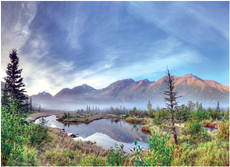
Subject Matter
When one peruses the literature regarding healing art, certain features are commonly cited as especially effective. In particular, representational images featuring green landscapes, water scenes, hill and country scenes, sweeping views, coastal views, marshes and farmland, groves of trees, beautiful vistas, sunrises and sunsets have been shown to be most beneficial.
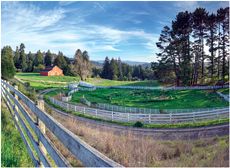
Composition
Compositional characteristics that further enhance healing art include: immersion (the presence of strong foreground elements and/or wide fields of view); extent (scenes of distant wilderness and/or paths that lead the viewer into a scene); and compatibility (a resonance between the natural and man-made worlds).[2] Specifically, “people have to feel that they can move into those spaces and have a wonderful experience.”[3]

Technique
By combining digital photography with computer graphics software, it becomes possible to produce imagery that more closely mimics how humans see. Healthy human eyes see with a very wide field of view, sharp focus and the ability to perceive an amazing range of color and contrast. Traditional photography can be rather limiting in these regards. However, using a technique we call “XYZ photography,” software can be used to blend and stitch together multiple views and exposures of a scene into a depiction that better conveys the feeling of a place and how we really perceive it.
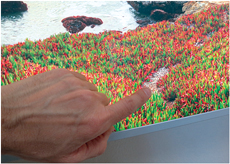
Fidelity
By using the XYZ photography method, one can produce large-scale images that are typically ten times finer than HDTV. This extraordinary level of detail helps deliver an uncannily immersive viewing experience that can be enjoyed at close range even with images 10 feet wide.
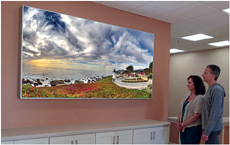
Illumination
With backlighting, these immersive images appear to be windows into another world, further enhancing their restorative qualities. Display light boxes can be readily sourced to house this imagery using the same bulbs that are used in bright light therapy to treat conditions such as seasonal affective disorder or sleep disruption. Combining immersive healing art and restorative light therapy in a single device — a scenic light box — offers a new option for enhancing quality of life in senior living communities and other caring environments.
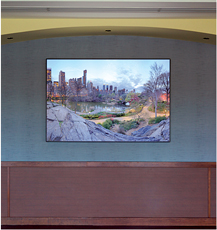
Results
The Hebrew Home at Riverdale, NY, chose a captivating image of Central Park at twilight for their first scenic light box installation, which hangs in their new dining facility (see above). The Hebrew Home has a long tradition of bringing art of all forms to their residents; their extensive world-class art collection was founded with the idea to bring a museum to residents who could no longer visit cultural institutions on their own. With this latest addition to their collection, they can now bring to their residents the pastoral beauty and restorative power of special places in the greater world.
Daniel Ambrosi is the creator of Bottled Light Productions LLC, an enterprise focused on producing large-scale scenic light boxes to help promote healing and well-being in senior living communities and other caring environments. He has also been an independent marketing consultant since 2003 and a published artist since 2011. He is based in Half Moon Bay, CA.
[1] Stewart B. “Are we being too innovative when we select healthcare art?” Healthcare Design v. 11 no. 2 (February 2011).
[2] Hathorn K and Nanda U. “A Guide to Evidence-based Art.” The Center for Health Design, 2008.
[3] Augustin S. “Place Advantage: Applied Psychology for Interior Architecture.” John Wiley & Sons, Inc., 2009.



